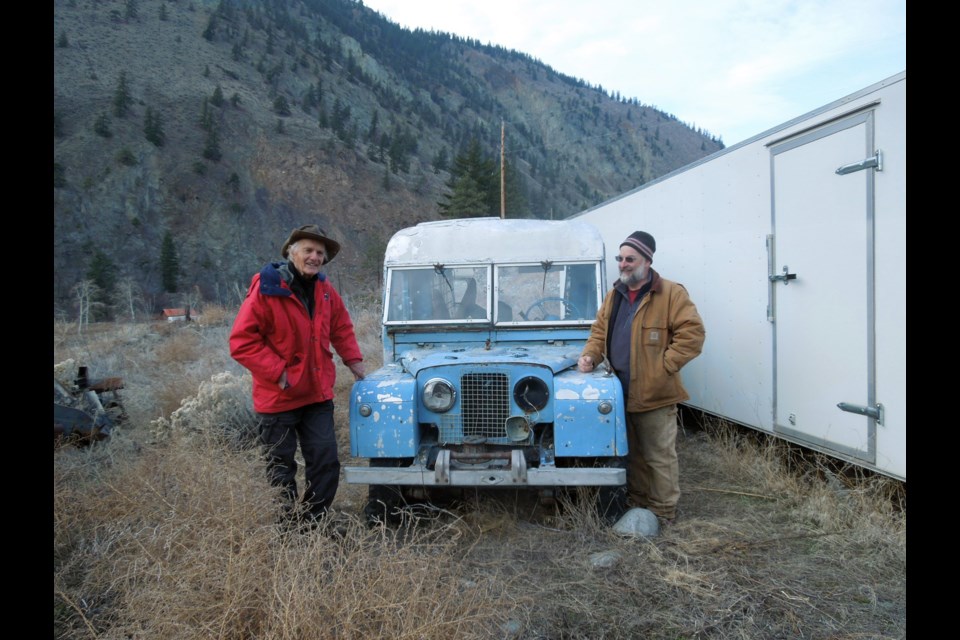Renowned Canadians and best friends, biologist Bristol Foster and naturalist-artist Robert Bateman, decided on a whim to travel the world.
It was the late 1950s and Foster, now 82, and Bateman, 84, were still in their 20s with neither wives nor significant responsibilities to keep them in Toronto.
But their 1957-58, 14-month trip through Africa, India, Southeast Asia and Australia, was made possible by one other travelling companion — their Land Rover, with its special, ambulance-style body and roof. The two called the vehicle Grizzly Torque and painted the name on the side of the truck.
Now Grizzly Torque has been found. The same vehicle that carried the pair through three continents, the same vehicle that was serviced and repaired by roadsides and wilderness creeks has recently resurfaced near Williams Lake.
Spotted on the Internet and purchased by a Land Rover buff in Vancouver, Grizzly Torque has been positively identified by Foster after a brief reunion about a month ago. It is being repaired, refitted and refurbished to its original 1957 condition in time for Bateman’s birthday on May 24 and the opening of a special museum exhibit about that trip.
The exhibit will be staged at the Robert Bateman Centre on Victoria’s Inner Harbour. It will feature photographs, writings, sketches, paintings and movie footage shot by the pair. The exhibit is titled The Rover Boys, and it will be taken around the world after its opening.
It will also be the subject of a special night, Around the World with Bateman and Foster, on Jan. 28, at the Royal B.C. Museum. Both men will talk and answer questions. Food and snacks will be provided, and visitors can take in the Wildlife Photographer of the Year exhibit.
Bateman and Foster have been friends since they were kids in Toronto. They met at a young naturalists’ club that gathered monthly at the Royal Ontario Museum, indulging a boyhood fascination with the natural world that has never abandoned them.
Foster would go on to head the B.C. Provincial Museum, later named the Royal B.C. Museum, and later be in charge of establishing B.C.’s ecological reserves. Bateman, of course, became one of the world’s finest wildlife artists. The two remain close and both live on Saltspring Island.
Bateman remembers laughing in 1956 when Foster called him up and asked how he liked the idea of driving round the world.
Foster had just finished a master’s degree in biology. He realized he had spent the past 20 years in school and was not ready to return to a classroom.
But Bateman hesitated. He had finished a degree in geography and was by then teaching public school. And at 26 he was desperate for a girlfriend.
“But I couldn’t find any young women who were also interested in nature,” Bateman said. “They were pretty scarce then.”
“So, I didn’t have a wife and I didn’t have a girlfriend, and when Bristol called I couldn’t think of a good reason not to go,’ he said in a telephone interview.
Bateman said he and Foster later sat down with a high school atlas and planned their trip. They agreed on equatorial Africa, northern India because it led to Nepal and the Himalayas, Burma, Thailand, Malaya and across to Australia.
The trip took 14 months and cost them $2,000 each. That included fares, food and shipping costs for Grizzly Torque. It even included the depreciation on the Land Rover, which the two men had agreed to pay to Foster’s father, who originally paid for the vehicle.
Foster’s father, a distinguished, well-connected businessman, also provided many letters of introduction to officials around the world. The only thing the concerned father asked in return was a promise the two young men would write home regularly, a task the two completed every day on a small portable typewriter.
Those letters were all received and later copied and made into a small book.
Bateman said Foster would eventually do all the driving on the trip because Grizzly Torque had been a gift from his father.
“I decided if it was going to get bashed or smashed, then [Foster] was going to be the one responsible,” said Bateman. “Instead, I did all the cooking.”
Bateman also said his friend deserves the most credit for organizing and arranging the trip.
Logistical support for Grizzly Torque even meant Foster travelled to the U.K. ahead of time for a course at Land Rover. Students took a vehicle apart and then put it back together.
Foster became so proficient he once removed a bent steering rod by the side of the road while travelling in the Cameroons in Africa. The rod was banged straight on the cement of a bridge and replaced before continuing.
Trip highlights for Bateman included meeting the Pygmy peoples in Central Africa, folk he called perhaps the most beautiful people he has ever known. Also, he still marvels at the memories of the high-altitude area of the headwaters of the Nile, where foliage had turned to giantism and become huge to fill specific, unique ecological niches.
Foster recalls the most memorable moments as encountering the wildlife of East Africa.
“As young naturalists, we were just blown away,” remembered Foster. “To be able to drive around rhinoceros, wildebeest and elephants was magical.”
“And it’s wide open country where you can actually see the animals,” he said.
Around the World with Bateman and Foster is on Jan. 28 at 7 p.m. Tickets are $50 ($45 for members).
For details, go online to the Royal B.C. Museum site at royalbcmuseum.bc.ca or the Robert Bateman Centre at batemancentre.org.
